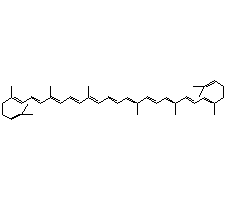Tomato plant extract
-
Post Date:
Feb 10,2025 -
Expiry Date:
Aug 09,2025 -
Detailed Description:
Cas No. :502-65-8Tomato P.E., 5~98% Lycopene
CAS#: 502-65-8
Main Contents: Lycopene
Plant Resource: Lycopersicon esculentum Mill.
Product Specification: 5,6,10,20,60,98%HPLC
Appearance: Reddish Brown Powder
Plant Part Used: Fruit
Extract Solution: Petroleum ether
Molecular formula and weight: C40H56, 536.873
Measurement system: HPLC adopted with ultrasonic assisting, dissolving
by chromatogram class petroleum ether. For further information, please
contact with lab@3wbio.com.
What is Tomato Extract?
Lycopene, effective ingredient of tomato extract, is a bright red
carotene and carotenoid pigment and phytochemical found in tomatoes
and other red fruits & vegetables, such as red carrots, watermelons and
papayas (but not strawberries or cherries). Although lycopene is chemically
a carotene, it has no vitamin A activity.
In plants, algae, and other photosynthetic organisms, lycopene is an important
intermediate in the biosynthesis of many carotenoids, including beta carotene,
responsible for yellow, orange or red pigmentation, photosynthesis, and photo-protection. Structurally, it is a tetraterpene assembled from eight isoprene units,
composed entirely of carbon and hydrogen, and is insoluble in water. Lycopene's
eleven conjugated double bonds give it its deep red color and are responsible
for its antioxidant activity. Due to its strong color and non-toxicity, lycopene is a
useful food coloring.
Lycopene is not an essential nutrient for humans, but is commonly found in the diet,
mainly from dishes prepared with tomato sauce. When absorbed from the stomach,
lycopene is transported in the blood by various lipoproteins and accumulates in the
liver, adrenal glands, and testes.
Because preliminary research has shown an inverse correlation between consumption
of tomatoes and cancer risk, lycopene has been considered a potential agent for
prevention of some types of cancers, particularly prostate cancer. However, this area
of research and the relationship with prostate cancer have been deemed insufficient of
evidence for health claim approval by the US Food and Drug Administration
Where will be Tomato Extract used to?
• Antioxidant
• Increasing immunity
• Prevent cancer, anti-cancer
• Alcohol cravings
• Prevent prostatitis
Packing Detail: Packed in paper-drums and two plastic-bags inside. Barrels outside printed name, gross weight, batch number,
production units, production time, effective time, storage and transportation methods.
Net Weight: 25kgs/drum.
Storage Situation: Stored in a well-closed container away from moisture and light.
Shelf Life:Two years under well Storage situation and stored away from direct sun light.
-
CAS Registry Number:
502-65-8 -
Synonyms:
;C.I. 75125;CI 75125;Lycopene Beadlet;LYCOSOURCE;LYCOPENE;JARCOPENE(TM);4,4-CAROTENE;2,6,10,14,19,23,27,31-OCTAMETHYL-DOTRIACONTA-2,6,8,10,12,14,16,18,20,22,24,26,30-TRIDECAENE;PSI,PSI-CAROTENE;Y,Y-CAROTENE;E 160d;(5cis,5'cis,9cis,13cis)-psi,psi-carotene; -
Molecular Formula:
C40H56 -
Molecular Weight:
536.8726 -
Molecular Structure:

-
Company:
3W Botanical Extract Inc. [ China ] -
Contact:
Harrison Chang -
Tel:
86-731-82938995 -
Fax:
86-731-82938822 -
Email:
Sales@3wbio.com